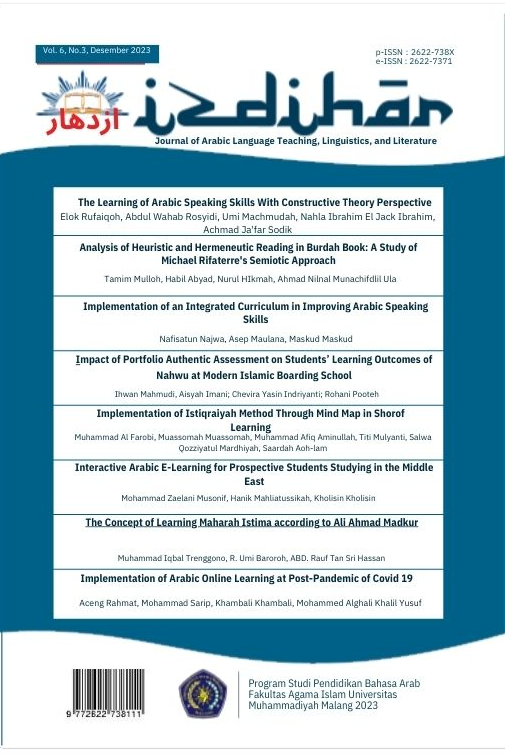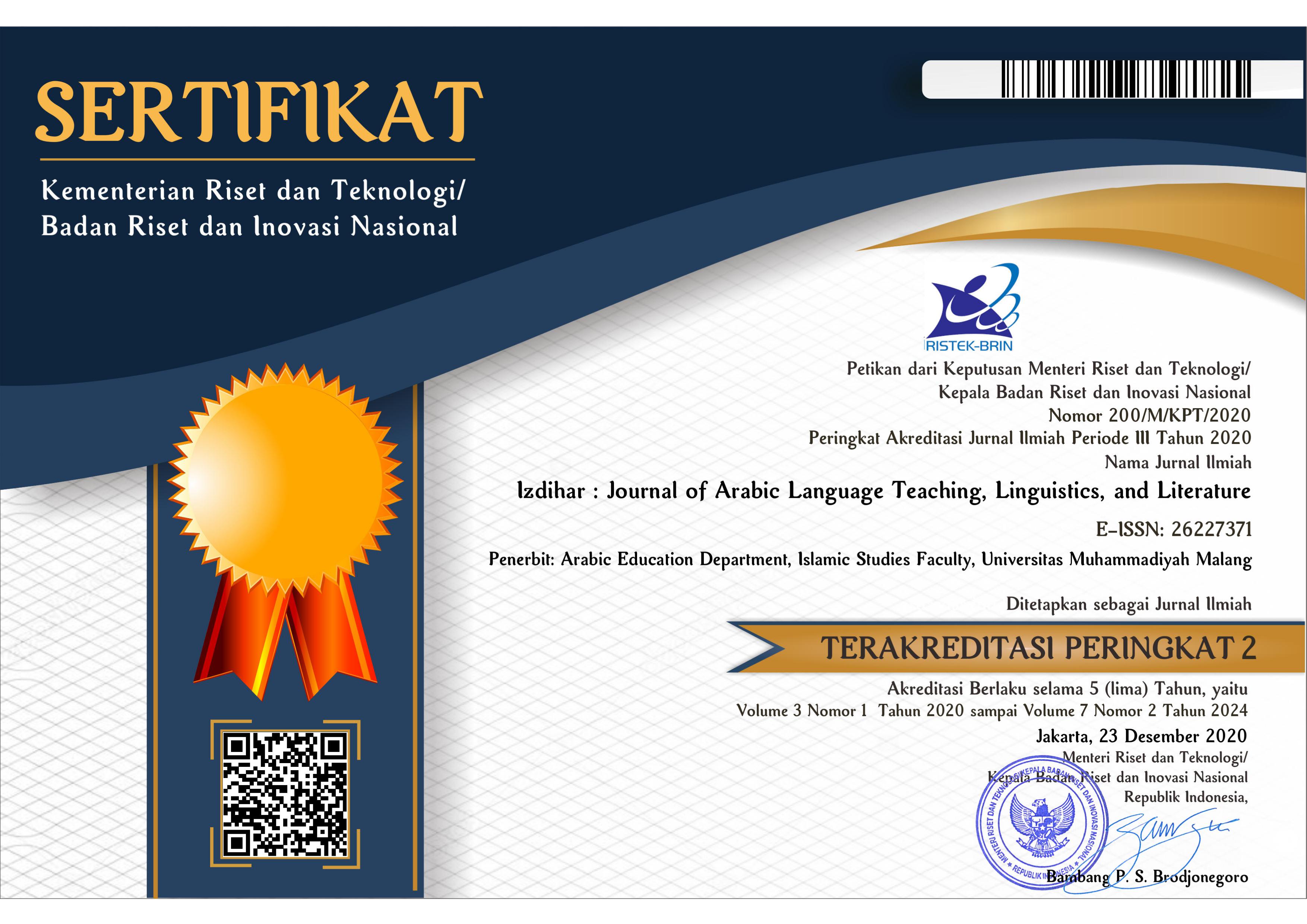Implementation of Arabic Online Learning at Post-Pandemic of Covid 19
DOI:
https://doi.org/10.22219/jiz.v6i3.31650Keywords:
Arabic Language Learning, Arabic Learning, Distance LearningAbstract
Entering the 21st century, education is using technology massively in learning activities, especially during the COVID-19 pandemic, so online learning is born with a variety of models and platforms. Online learning is generally divided into two categories: MOOCs (massive open online courses) and LMSs (learning management systems). This study aimed to show how online learning is built and how it can be implemented into different learning models. The study used descriptive qualitative research aimed at revealing the phenomenon of the preparation and implementation of online Arabic learning post-COVID-19 pandemic, based on data obtained from various literature and observations. The results revealed that in order to build and implement online Arabic language learning, the first research was carried out in the form of RPS and textbooks in PDF and/or video formats so that the material could be integrated into the online platform, and then the implementation of online learning could be in different models, whether blended, hybrid, or flipped, depending on the learning model structured in the planning document.
Downloads
References
Adawiyah, Y. R. (2020). Implementasi Pembelajaran Bahasa Arab Berbasis E-Learning. Al Yasini, 5(2), 521–542. http://ejournal.kopertais4.or.id/tapalkuda/index.php/alyasini/article/view/3791.
Adzharuddin, N. (2013). Learning Management System (LMS) among University Students: Does It Work? International Journal of E-Education, e-Business, e-Management and e-Learning. https://doi.org/10.7763/ijeeee.2013.v3.233
Ahmed, S. (2017). Authentic ELT Materials in the Language Classroom: An Overview. Journal of Applied Linguistics and Language Research, 4(2), 181–202. https://www.jallr.com/index.php/JALLR/article/view/551
Al-Kindi, I., Al-Khanjari, Z., & Kraiem, N. (2017). Sultan Qaboos University between E-Learning and Massive Open Online Course : Future Vision. Free and Open Source Software Conference (Fossc-17), February. https://www.researchgate.net/publication/313876351_Sultan_Qaboos_University_between_E-Learning_and_Massive_Open_Online_Course_Future_Vision
Aydin, C. H. (2017). Current Status of the MOOC Movement in the World and Reaction of the Turkish Higher Education Institutions. Open Praxis, 9(1), 59. https://doi.org/10.5944/openpraxis.9.1.463
Beny, Wijaya, I. S., & Assegaf, S. (2014). Why Indonesian Universities Should Take Benefits from MOOC (Massive Open Online Course). https://www.researchgate.net/publication/283725117_Why_Indonesian_Universities_Should_Take_Benefits_from_MOOC_Massive_Open_Online_Course
Creswell, J. W. (n.d.). Research Design Qualitative, Quantitative and Mixed Methods Approaches (3rd ed.). Sage.
Debevc, M., Venuti, M. Z., & Peljhan, Z. (2003). E-Learning Material Planning and Preparation. Faculty of Electrical Engineering and Computer Science. https://www.researchgate.net/publication/267719367_E-learning_material_planning_and_preparation
Persyaratan dan Prosedur Pendirian Perguruan Tinggi Swasta Penyelenggara Pendidikan Jarak Jauh Pendidikan Akademik, Pub. L. No. 83/E/KTP/2020, Dirjen Pendidikan Tinggi Kemendibud 1 (2020). https://lldikti15.kemdikbud.go.id/wp-content/uploads/2022/12/Persyaratan_Prosedur_Pendirian_PTS-_PJJ_Akademik-2.pdf
Hamidah. (2019). Al lughoh Al ’arobiyah Bayna Mustalzimah Al ta’allum wa Masuliyatihi. Al-Ta’rib, 7(1), 35–44. http://e-journal.iain-palangkaraya.ac.id/index.php/tarib/issue/view/149
Hill, D. A. (2013). The Visual Elements in EFL Coursebooks. In B. Tomlinson (Ed.), Developing Materials for Language Teaching.
Husain, B. M. M. (2020). Tathwir Barnamij I’dad Mu’allim Al-ulum Fi Al-Ashr Al-roqmi Wifqon Liithor TPACK. Al-Majallah Al-Tarbiyah, 70, 1–58. https://doi.org/10.12816/EDUSOHAG.2020.66701
Irfan, M., Suryaningrum, C. W., Pusporini, W., & Widodo, S. A. (2023). Online learning effect of post-pandemic COVID-19: A survey at universities in Indonesia. Perspektivy Nauki i Obrazovania, 61(1). https://doi.org/10.32744/pse.2023.1.34
Itmazi, J. (2016). Using Technology in Teaching and Learning Arabic Language for Non-Arabic Speakers: Proposed Structure of MOOC Course (3). https://www.researchgate.net/publication/301291986_Using_Technology_in_Teaching_and_Learning_Arabic_Language_for_Non-Arabic_Speakers_Proposed_Structure_of_MOOC_Course_astkhdam_altqnyat_alalktrwnyt_fy_tdrys_wtlym_allght_alrbyt_llnatqyn_bghyrha_mkhtt_mq
Izzuddin, Maulana, A., Ma’mun, T. N., & Mannaa, H. S. (2020). The Curriculum Development of Arabic Instruction to Improve Student’s Writing Skills. Universal Journal of Educational Research, 4261–4272. https://doi.org/10.13189/ujer.2020.080952
Jaramillo-Morillo, D., Ruipérez-Valiente, J., Sarasty, M. F., & Ramírez-Gonzalez, G. (2020). Identifying and characterizing students suspected of academic dishonesty in SPOCs for credit through learning analytics. International Journal of Educational Technology in Higher Education, 17(1). https://doi.org/10.1186/s41239-020-00221-2
Kats, Y. (2010). Learning management system technologies and software solutions for online teaching: Tools and applications. In Learning Management System Technologies and Software Solutions for Online Teaching: Tools and Applications. https://doi.org/10.4018/978-1-61520-853-1
Lestari, A. S. (2014). Aplikasi Moodle dalam E-learning. Orbit Publishing Jakarta.
Liu, Z.-Y., Lomovtseva, N., & Korobeynikova, E. (2020a). Online Learning Platforms: Reconstructing Modern Higher Education. International Journal of Emerging Technologies in Learning (IJET), 15(13), 4. https://doi.org/10.3991/ijet.v15i13.14645
Liu, Z.-Y., Lomovtseva, N., & Korobeynikova, E. (2020b). Online Learning Platforms: Reconstructing Modern Higher Education. International Journal of Emerging Technologies in Learning (IJET), 15(13), 4. https://doi.org/10.3991/ijet.v15i13.14645
Muhaiban. (2016). Penulisan Buku Ajar Bahasa Arab. 245–255.
Mukhtar, K., Javed, K., Arooj, M., & Sethi, A. (2020). Advantages, limitations and recommendations for online learning during the COVID-19 pandemic era. Pakistan Journal of Medical Sciences, 36(COVID19-S4), S27–S31. https://doi.org/10.12669/pjms.36.COVID19-S4.2785
Muslimin, J. (2020). Menemukan Akar Kegagalan Pembelajaran Bahasa Arab di Indonesia. JURNAL INDO-ISLAMIKA, 6(1), 167–177. https://doi.org/10.15408/idi.v6i1.14801
Surat Edaran tentang Penyelenggaraan Pendidikan di Perguruan Tinggi, Pub. L. No. 2, Dirjen Pendidikan Tinggi, Riset dan Teknologi 1 (2022). https://lldikti3.kemdikbud.go.id/v6/wp-content/uploads/2022/05/Surat-Edaran-Plt.-Dirjen-Dikti-Nomor-2-Tahun-2022-Tentang-Penyelenggaraan-Pendidikan-di-Perguruan-Tinggi.pdf
Ra, S., Jagannathan, S., & Maclean, R. (Eds.). (2021). Powering a Learning Society During an Age of Disruption (Vol. 58). Springer Nature Singapore. https://doi.org/10.1007/978-981-16-0983-1
Richards, J. C. (2001). The Role and Design of Instructional Materials. In Curriculum Development in Language Teaching (pp. 251–285). Cambridge University Press.
Sofyan, S. (2020). Sejarah Perkembangan Bahasa Arab dan Lembaga Islam di Indonesia. Insan Cita, 5(1), 73–88.
Sugiyono. (2013). Metode Penelitian Kuantitatif Kualitatif dan R&D. Alfabeta.
Shareef, Abdelqadeer (2019). Raymond Lool wa Madrasat Meermaar Li-Taleem Al-lughot Al-Arabiyat Fii Mishr Baina At-Tahsiil Al-Ilmy wa Khidat At-Tansir (Josoor Al-Ma’rifa, 5 (1), 229-135
Thahir, M., Widiawati, W., & Baitillah, N. (2023). The Post-Pandemic Education : A Blended Learning Approach For Teaching And Learning In Higher Education in New Normal Era. International Journal of Ethno-Sciences and Education Research, 3(3). https://doi.org/10.46336/ijeer.v3i3.461
United Nations, Pub. L. No. 3190, United Nation 356 (1974). https://digitallibrary.un.org/record/191371#record-files-collapse-header
Veluvali, P., & Surisetti, J. (2022). Learning Management System for Greater Learner Engagement in Higher Education—A Review. Higher Education for the Future, 9(1). https://doi.org/10.1177/23476311211049855
Volchenkova, K. (2016). Blended Learning: Definition, Models, Implications For Higher Education. Educational Sciences, 8(2), 24–30. https://doi.org/10.14529/ped160204
Wan Ab Aziz, W. D., Mohammad, Taufiq, A. G., Ahmad Zaki, A., Ahmad, A. R., NorAbdul, R., & AmaneeAbdul, H. (2018). MOOC at Universiti Malaysia Kelantan: Need Analysis Study for the Development of Arabic Language Online Course. International Journal of Arts Humanities and Social Sciences, 3(2). http://www.ijahss.com/vol3-issue2.html
Yunus, H. (2021). Online Learning Management System (OLMS) in Indonesian Higher Education: Investigating Benefits and Obstacles. P-JEIS, 1–9. https://journal.parahikma.ac.id/pjeis/article/view/42#:~:text=As%20the%20findings%2C%20there%20are,students%20and%20lectures%20face%20during
Zurqoni, Z., Retnawati, H., Rahmatullah, S., Djidu, H., & Apino, E. (2020). Has Arabic Language Learning Been Successfully Implemented? International Journal of Instruction, 13(4), 715–730. https://doi.org/10.29333/iji.2020.13444a
Downloads
Published
How to Cite
Issue
Section
License
Copyright (c) 2024 Aceng Rahmat, Mohammad Sarip, Khambali Khambali, Mohammed Alghali Khalil Yusuf

This work is licensed under a Creative Commons Attribution-ShareAlike 4.0 International License.
Copyright Notice
Authors who publish with this journal agree to the following terms:
- Authors retain copyright and grant the journal right of first publication with the work simultaneously licensed under a Creative Commons Attribution-ShareAlike 4.0 International License that allows others to share the work with an acknowledgment of the work's authorship and initial publication in this journal.
- Authors are able to enter into separate, additional contractual arrangements for the non-exclusive distribution of the journal's published version of the work (e.g., post it to an institutional repository or publish it in a book), with an acknowledgment of its initial publication in this journal.
- Authors are permitted and encouraged to post their work online (e.g., in institutional repositories or on their website) prior to and during the submission process, as it can lead to productive exchanges, as well as earlier and greater citation of published work (See The Effect of Open Access).
Copyright (c) 2019 Izdihar : Journal of Arabic Language Teaching, Linguistics, and Literature

This work is licensed under a Creative Commons Attribution-ShareAlike 4.0 International License.


















